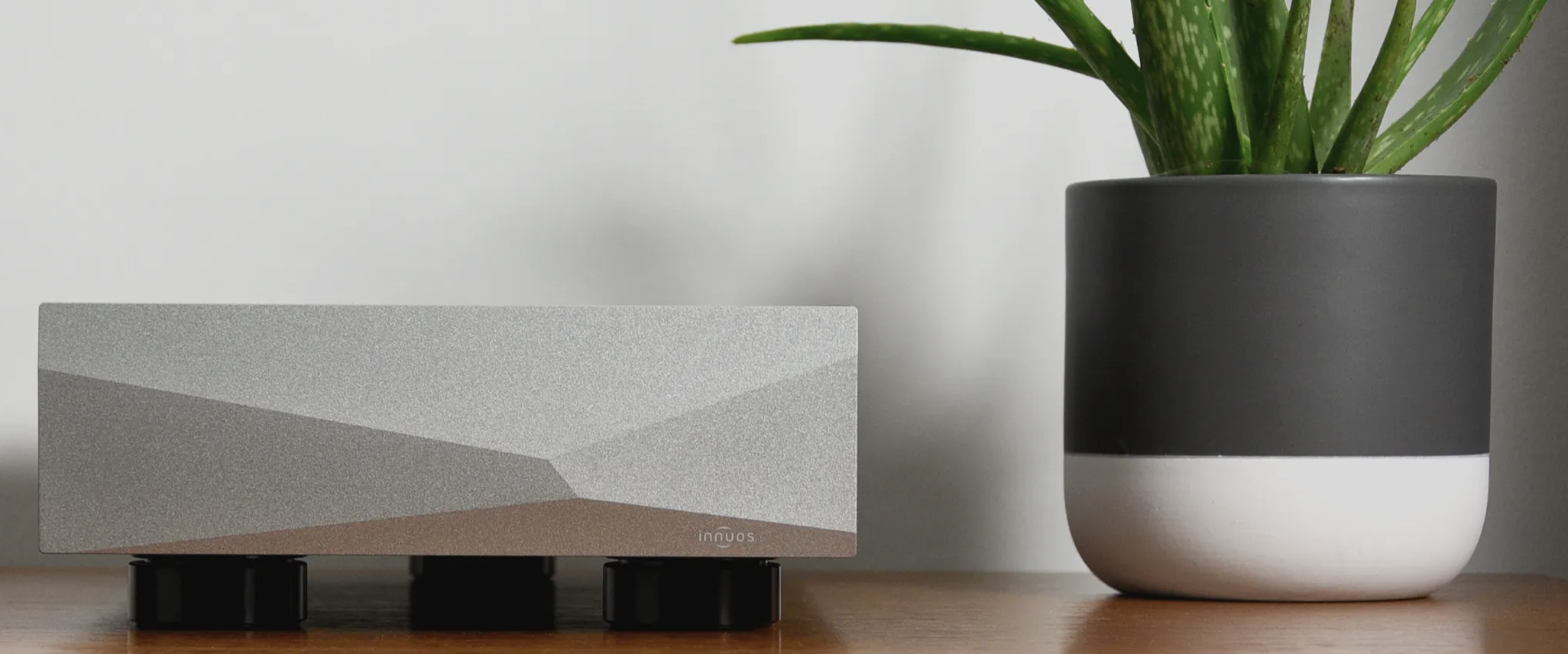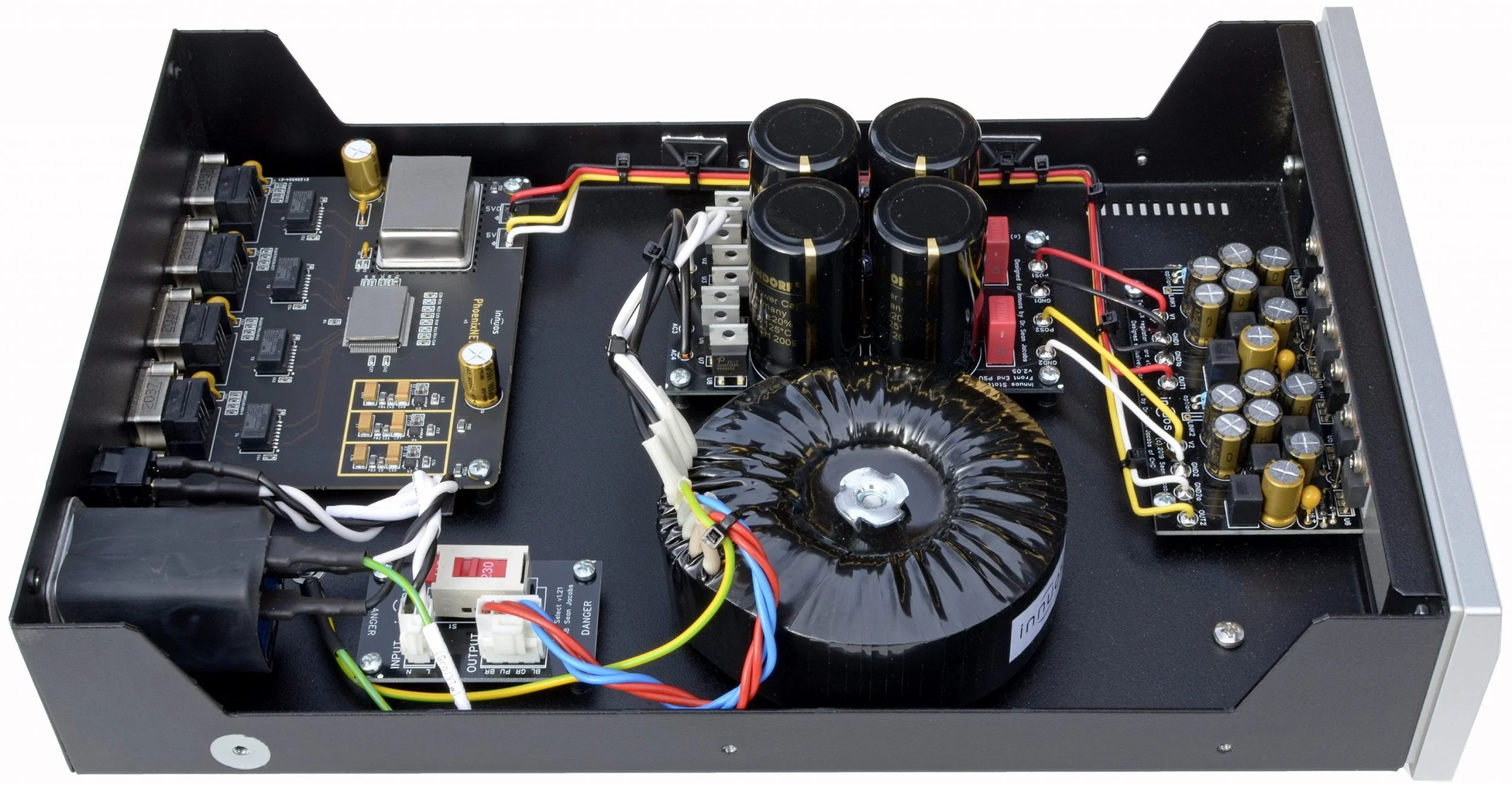A Phoenix from the flames - the INNUOS PhoenixNET audiophile internet switch.
/An often touchy subject, especially on certain internet hi-fi forums where debate (that’s a polite way of describing it) carries on like a proverbial juggernaut, network switches polarise opinion as much as many a political, religious or ethical discussion in the mainstream press…
Not wanting to throw petrol onto the fire, I will seek to present our point of view on the topic as a whole, but with an emphasis on enlightening you about a top-quality product from the Innuos stable, the PhoenixNET audiophile network switch.
Innuos PhoenixNET audiophile switch
innuos phoenixnet in silver
The PhoenixNET audiophile internet switch is manufactured by Portuguese hi-fi specialists Innuos, established by husband and wife duo, Nuno Vitorino and Amelia Santos in 2009.
Innuos have made a name for themselves in the audiophile community over the last decade, by providing high-end music streaming solutions for music lovers wanting to go beyond the traditional cd players of yore. Indeed, their Innuos Statement server/ripper has received high praise in the upper echelons of the audiophile community, where ultimate playback sound quality is concerned. The trickle-down knowledge from developing a system such as this has allowed the development of several additional products in their range. One is the Innuos PhoenixNET audiophile switch and the other the Innuos PhoenixUSB re-clocker, both of which have received exceptionally positive feedback from the community.
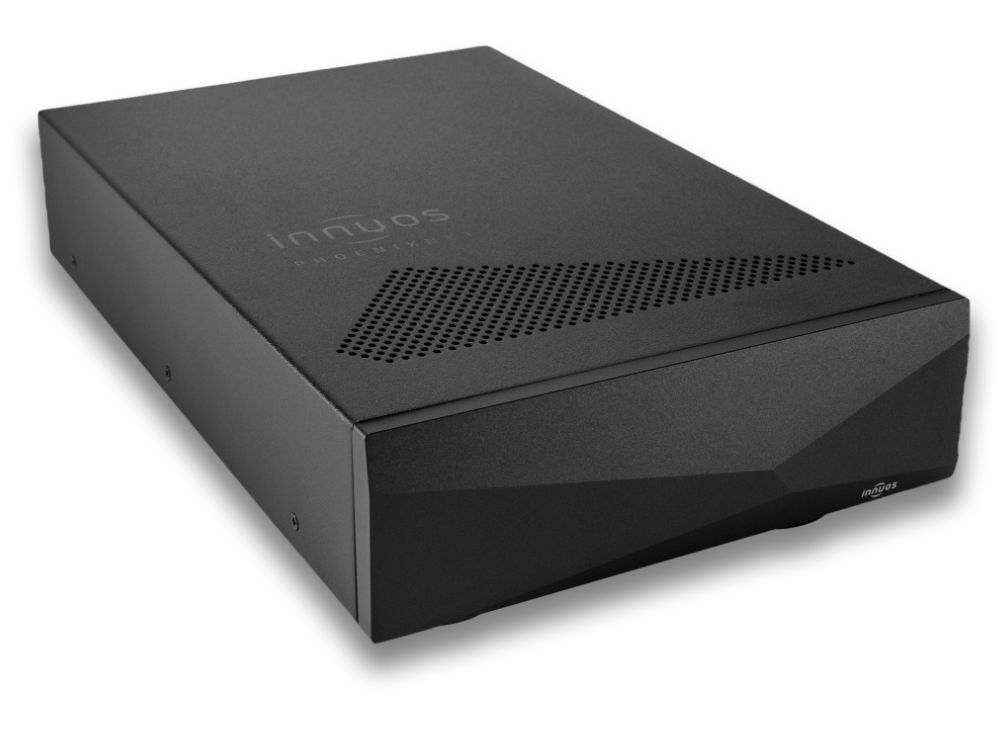
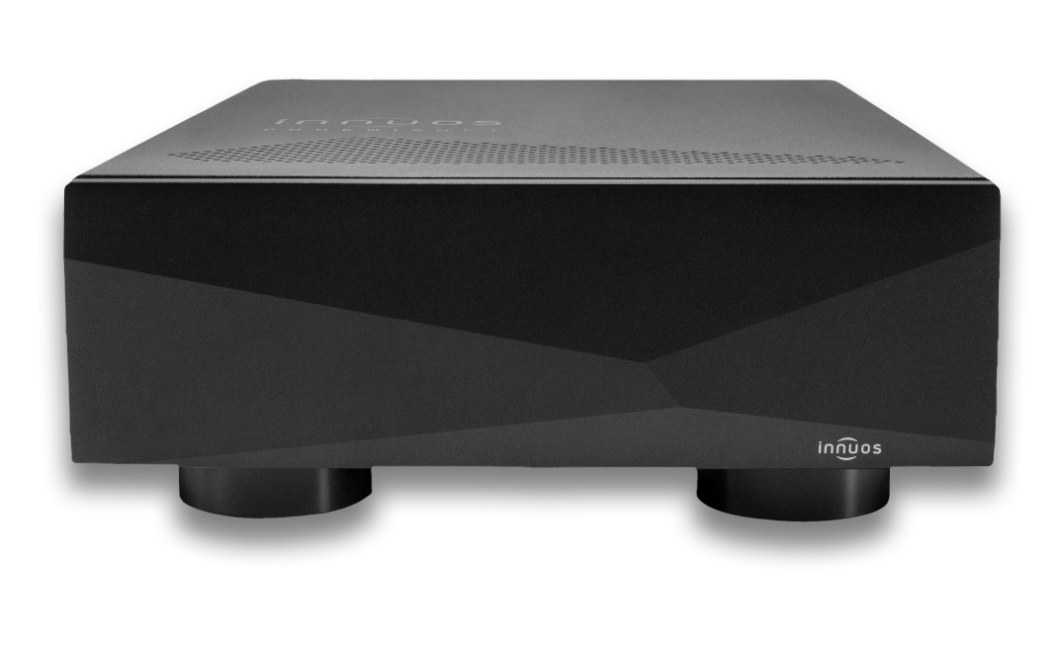
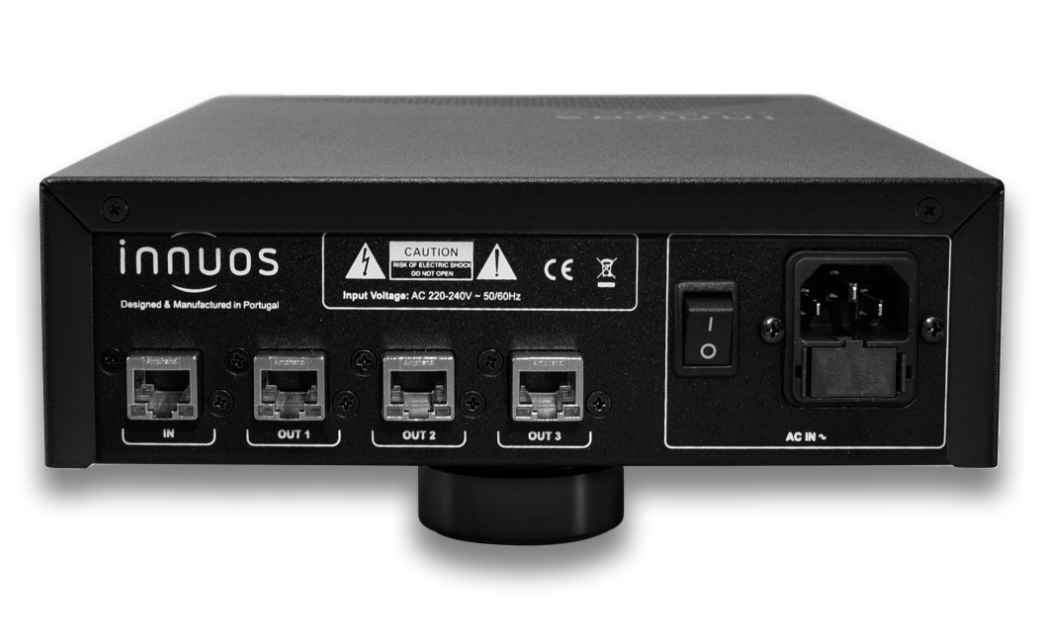
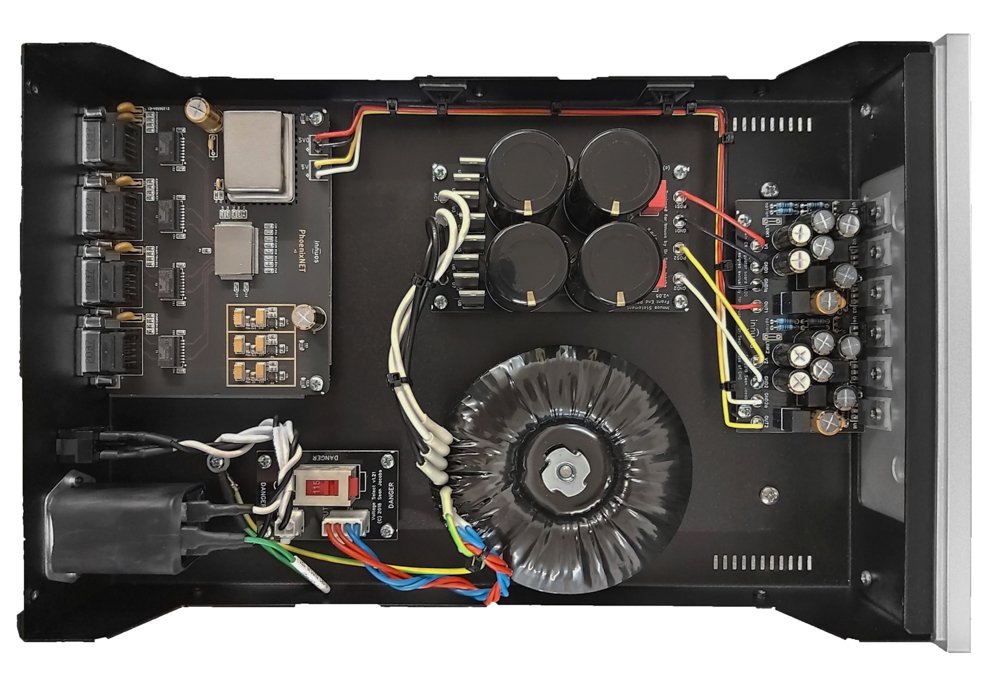
So, what is the Innuos PhoenixNET audiophile ethernet switch all about?
Quoting from the Innuos website, the primary design criteria are to:
1. Minimize Network Switch Noise
Simpler 100mbps network switch chip results in lower operating noise floor compared to Gigabit
Network switch chip with no internal switching regulators. All 3 independent voltages supplied by internal Statement-grade linear power supply with independent ultra-low noise regulation.
Massive individual Network Isolation Transformers to further isolate from noise coming from router or connected devices
Just the right amount of Individually shielded, high quality ethernet ports soldered directly to the board with no ethernet activity lights as blinking leds introduce considerable electrical noise.
EMI absorption at the right places so that interference produced can be captured before influencing other components.
2. Increase Clocking Precision and Stability
Using the same 3ppb 25 MHz OCXO oscillator as used in the Statement, individually powered by its own linear power supply and connected directly to the network switch chip, avoiding precision losses from using external master clocks.
3. Provide Pristine Power to the Components
Two independent STATEMENT-grade linear power supplies with Mundorf Caps to power individually the OCXO clock and the mainboard, keeping the power path short with less opportunity for EMI contamination.
4. Minimize Vibration on Components
Vibration was managed at 3 levels: Anti-Vibration feet tuned to the resonant frequency of the chassis, top cover treatment to convert vibration captured from sound waves into small amounts of heat and sturdy RJ45 ports with silicone connection to the chassis.
innuos phoenixnet interior
Innuos PhoenixNET switch - what you need to know...
Here at Audio T in Brighton, we have been using a regular internet switch for years, a dependable Cisco 2960, primarily because of the large number of devices requiring an internet connection and the reliability of wired connection over multiple wireless connections.
More recently, the Cisco 2960 developed a fault and was replaced by an English Electric EE8 switch. The three of us noted a change in the sound, some beneficial, some not, but this isn’t a review of them so onto the next part of the story.
We then took in a demonstration Innuos PhoenixNET audiophile internet switch and the moment we connected it up, the three of us here at Brighton Audio T, looked at each other in astonishment because the improvements were that marked.
As the days have passed with our Innuos PhoenixNET audiophile internet switch, the sound has continued to improve as the power supply and OCXO clock have stabilised.
Let me explain this stabilization process some more. According to Innuos, the OCXO clock will improve after powering up because part of its design includes a cutting-edge oven-controlled crystal oscillator reaching a perfect operating temperature during several hours/days of operation. The 3 parts per billion accuracy of the OCXO fitted to the Innuos PhoenixNET is just one of the benefits of running this switch in your streaming hi-fi system and matches the specification of the Innuos Statement, their top performing product. The re-clocking done by the switch affects the timing of the digital signal, allowing your DAC to have an easier job when doing its conversion into an analog output signal, or at least that’s the theory and certainly borne out in our listening sessions.
We have many hi-fi systems on demonstration here at Audio T in Brighton and those that require network connectivity have all benefited from the Innuos PhoenixNET being included in the system. The only real downside to the Innuos PhoenixNET is that it only has one input and three outputs, limiting the number of ethernet devices in a simultaneously connected system. Not the end of the world really, just requires some additional unplugging of ethernet cables and for most people, the one input/three outputs may be sufficient, unless your home is like an Audio T hi-fi shop.
innuos phoenixnet image showing its single input & 3 output rj45 ethernet sockets
As mentioned earlier in the blog, special attention has been given to reducing noise and interference in the design, with high quality sockets to reduce electromagnetic interference, EMI and specially tuned feet to reduce the negative sonic effects of microphony. The Sean Jacobs DC3 based linear power supply includes Mundorf capacitors and shorter signal paths, all designed to stabilise power supplies serving the internal components, in order to reduce digital noise coming in/out of the switch.
Let’s get personal...
I am fortunate enough to own a rather nice Naim system of my own, consisting of: Naim Uniti Nova used as a preamp into a Naim NAP250DR power amp and Proac Tablette 10 Signature speakers with a REL Stampede subwoofer.
I was so enamoured by the benefits of the Innuos PhoenixNET audiophile network switch whilst it was in store, I had to try one myself at home.
I’ve only had the Innuos PhoenixNET at home for a short time, but after hearing the benefits it brought to streaming via Qobuz and a Naim Uniti Core in our Brighton Audio T shop, using several Naim systems, including a fully specified 500 system, a recent 200 series Naim system and other various streaming devices, I was optimistic, to say the least.
My own Naim system has been transformed in so many areas since the introduction of the Innuos PhoenixNET. Personally, I have long believed that noise transferral, whether through mains or interconnect/Ethernet cables, has a detrimental effect on sound quality, especially in 3d spatial cues, tonality, transparency, clarity, micro-dynamics and overall musicality. The further down the hi-fi rabbit hole one ventures, for every answer come more questions, but that’s part of the fun!
Depending on your system, to varying degrees these are all audible, but not really that measurable, except with our ears! This is one of the main reasons detractors argue that internet switches cannot make a difference to the sound, because they can’t measure the effects easily, or that differences are at a level we cannot hear anyway. As I have mentioned before, the effects are quite audible, to our ears!
Quite frankly, the Innuos PhoenixNET ethernet switch is like a power supply upgrade, only to realise, it sort of is a power supply upgrade and so much more. We’re treading new ground when it comes to digital noise suppression knowledge and the Innuos PhoenixNET polishes the floor very nicely indeed!
I also think there is the potential of quite a lot more experimentation to be done in acquiring the optimum sound balance in a hi-fi system with ethernet switch implementation, different types of power supply, be it SMPS or LPS, mains supply/filters and mains cables. On that note, we strongly recommend the use of Naim Powerlines or Naim Powerline Lites to supply your hi-fi components, especially those from Naim.
I remember when I first got into hi-fi, the old adage of, “Rubbish in, rubbish out!” being used all the time when considering a turntable system and I see and hear no reason why this shouldn’t apply to digital front-end systems as well. You cannot get more source orientated than a digital signal being fed from your router, via an ethernet switch, to a streamer/DAC, so perhaps it shouldn’t be so surprising that the Innuos PhoenixNET switch is so effective after all.
As always, the proof of the pudding is in the eating, so get in touch to book a demonstration.
Thanks for reading.
Ade, John and Paul - Audio T Brighton
If you have any questions about any of the equipment featured in this article, or any other Hi-Fi or home cinema enquiries, be sure to Contact Us.
If you’ve enjoyed this, why not go ahead and read some more of our other blogs, and be sure to follow us on our social media channels below…


